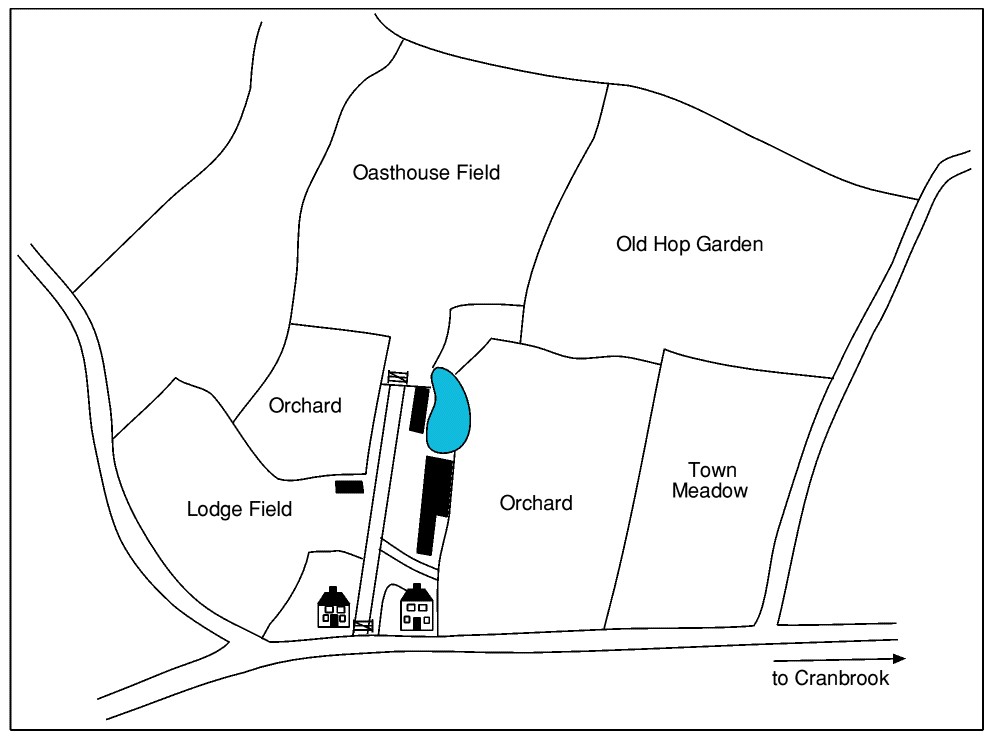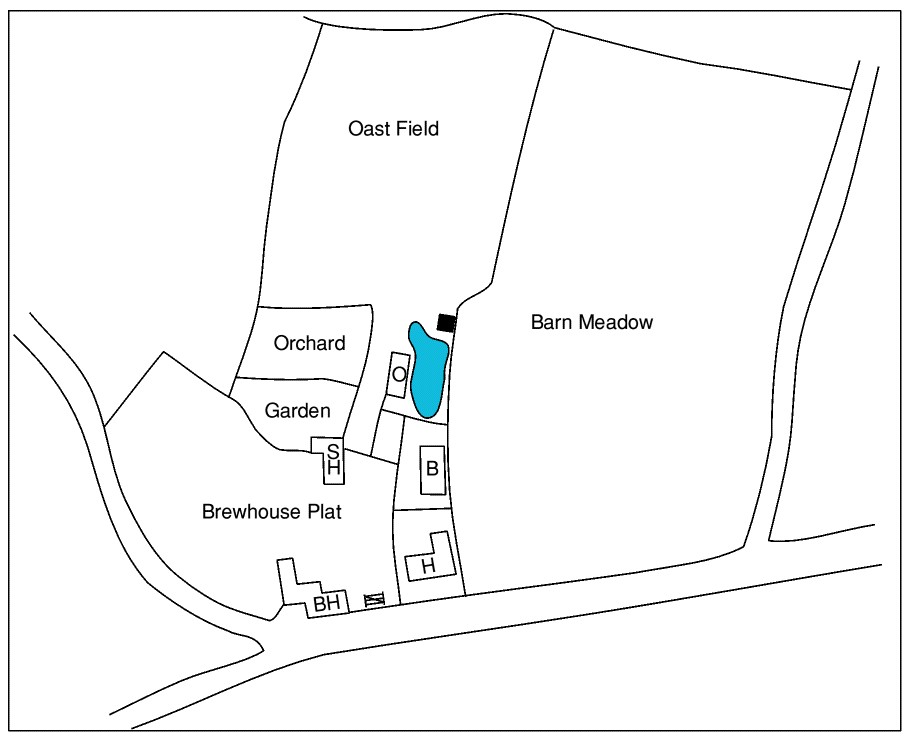From Dyehouse to Brewhouse |
|
The History of Baker's Cross, Cranbrook, part 1 - Tony Singleton
Few people may think of the Baker's Cross area of Cranbrook as an industrial estate and yet for centuries it has been the site of some form of manufacturing activity and today is the home of Tudor Oak, makers of reproduction antique furniture. This is the first of two articles tracing the occupation and varying uses to which the area has been put over the centuries. 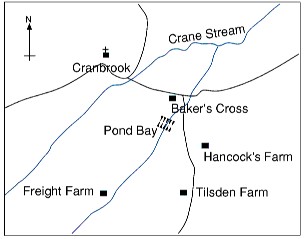 The area around Bakers Cross The earliest documentary reference to industrial activity in this area is in 1500 when William Cosscheman, clothman died, leaving 40 shillings in his will for the repair of the foul ways between Cranbrook and Hancock's mill (1). The Hancocks who gave their name to the farm nearby may have been involved in the cloth trade with a fulling mill near Baker's cross, or the mill may have been a water-powered corn-mill. However, if this was so, by 1516 the old mill had been rebuilt or replaced since the will of Robert Dowle (2) refers to Thomas Sheffe's new fulling mill. Thomas Sheaffe had purchased the Hancock's properties, probably during the 1490s, and when he died in 1520, left Hancocks Farm to his son Gervase. His son John inherited a messuage and mill at Baker's Cross, with the weirs, ponds, and three pieces of land called Bakers, which I late bought of Walter Robert, Esq. (3). So it appears that he had added to the original mill site by further land purchase. The present garden of Grove Cottage has as its southern boundary a substantial man-made bank across the stream valley about 200 metres south of Baker's Cross and may well be the site of Thomas Sheaffe's new fulling mill. The pond created by this dam must have flooded several hundred metres upstream and would explain why Thomas Sheaffe refers in his will to water rights which I have of Robert Brickenden. The latter farmed Freight Farm which lies to the south (and upstream)of the Baker's Cross site and some of its fields would have been flooded by the pond held back by the dam. Not much more is known of the site during the 16th century but it seems to have been developed by the Sheaffe family as the centre of their cloth operations in the parish. By the end of the century, the property had passed to Thomas' grandson, another Thomas, whose son Alexander was operating the business here until he pre-deceased his father in 1601. When the younger Thomas died in 1604 (4), he bequeathed to Alexander's widow, Phoebe, his messuage and tenements, dyehouse, copper vessels, implements in the dyehouse, gardens, orchards, and lands thereto, called Bakers until his grandson, (yet another Thomas!)reached 24. No mention of the mill is made suggesting that it may have ceased functioning by this date. Certainly, Alexander had been sending cloth to Maidstone to be fulled just before his death in 1601 (5). The size of the stream at Baker's Cross must have mitigated against its use in powering a mill for more than just a few months of the year but it would have been vital for supplying the water for a dye-house. This might well explain the quitrent payable to Glassenbury manor which included 2d for a pale to take in the Well on the Lords waste there in length 200ft in breadth 12ft. For an area such as this to be fenced off, it suggests that water was being piped or somehow conveyed from one of the natural springs nearby to a building such as a dyehouse downstream towards Baker's Cross. Alexander had died at the age of 34 while his cloth business was in full swing, leaving four young children and a widow. His inventory (6) reveals that Baker's Cross was a hive of industry at the beginning of the 17th century. The house which stood there must have been substantial with hall, parlour, kitchen, milkhouse and buttery, and six chambers over them; both male and female servants were in residence. The parlour, in common with many clothiers' houses, was used as the repository for finished broadcloths including 3 Stone grayes, 2 olive grayes, 2 black & white grayes and one course sage Color. Two dutch marbles were at the weavers and five more of various colours were in London awaiting sale. 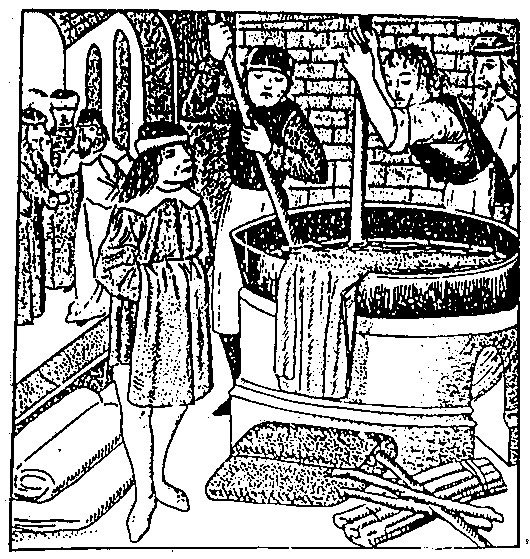 Dyeing with woad In addition to the copper vessels and implements in the workhouse nearby, the movables included a woadnett and a trench, a fate healer (vat lid)and bressel baggs. As well as woad (for blue)and brasil wood (for red), the Sheaffes were one of the few clothiers in Cranbrook at this time to be using cochineal for dyeing and there were 60 loads of wood and faggots to fuel the dye-vats and the domestic fires. The smell and smoke, repeated in many places throughout the parish, must have created quite an unpleasant atmosphere. Even so, there was also a substantial farm in operation with the principal crops in the barn being wheat and hay. The inventory was taken on 20th October. One field, however, must have been occupied by the two hardles, used for drying washed and dyed wool, and the tainter or tenter frame used for drying fulled cloth. The Glassenbury manor rental for 1603 (7) tells us the extent of the property in the following entry: Thos Sheaffe, s of Alex Sheaffe for a In the early decades of the sixteenth century, it was becoming clear that the cloth industry in this area was past its heyday and many who had the means left to start a new life in America although we have reason to believe that the younger Thomas probably settled in Worcestershire. Consequently, the Baker's Cross property was leased to other clothiers over the next few decades. In 1658, Captain John Basden, clothier, is mentioned in the parish registers as being of Bakers Cross and may have leased the property for a short while before his death in 1661. He had just remarried after the loss of his first wife, four years earlier, when he had been living at Collins Place in Milkhouse Street (now Sissinghurst)(8). The earliest mention of Baker's Cross in the Cranbrook rate books records that Jonah Fuller was the ratepayer in 1684 (9) so it seems that he had purchased it after the death of Thomas Sheaffe in Worcestershire in 1669. Certainly by the early 1700s the cloth industry had all but vanished and there is no evidence that Jonah Fuller was any more than a farmer. After his death in 1693, the farm passed to Thomas Fuller who sold it for £230 to Sir Thomas Dunk of Hawkhurst in 1715 (10). The deed described the property as: Two messuages or tenements now divided into 3 dwellings with the Brickell (brick kiln)thereunto belonging together with the Barnes Edifices Buildings Closes yards Gardens Orchards and several pieces of land meadow pasture and woodland called Bakers Cross. The mill and dyehouse may have disappeared but a brick kiln was in operation at this date, maintaining the industrial atmosphere. How many buildings in Cranbrook contain bricks made here, I wonder? Sir Thomas Dunk died in 1718 leaving his executor William Richards to carry out his wish to build the almshouses in Hawkhurst which he had endowed. So it is that in the manor rental of 1728, Mr Richards is recorded as paying the quitrent (11). 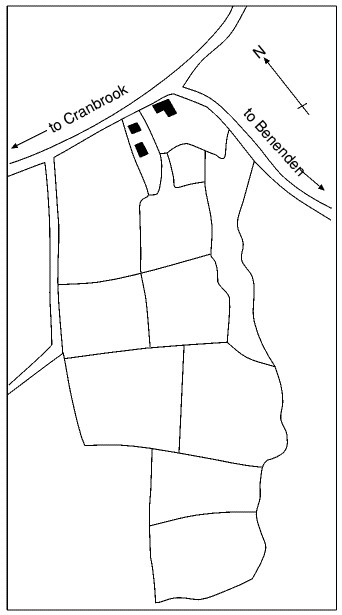 Baker's Cross Farm Throughout the 18th century, Bakers Cross remained a tenanted farm, Thomas and William Fryman farming it for much of the first half of the century, William Marchant taking over the tenancy in 1760. Soon after this, the farm was purchased by Richard Willis, a Cranbrook solicitor, who commissioned James Rofe to produce a map of his newly acquired estate in 1766 (12). The map reproduced here is taken from it and shows the 33 acres originally owned by the Sheaffes. The two messuages or tenements are shown clearly on the plan standing on either side of what is now Dorothy Avenue. One stands today, divided into two dwellings, bearing the names Sheaffe House and Little Baker's Cross but its design suggests that it was probably built just before this date for Willis to live in. The other may have been the original Sheaffe property and was presumably the farmhouse until it was demolished at the end of the century. It is not known when brickmaking ceased on the farm although the approximate site of the kiln can be located since a Brick Kiln Field is recorded on this estate map. Richard Willis also owned Freight Farm and much other property besides but had overstepped himself financially and was declared bankrupt in 1776 (13). This was a fate which dogged many owners over the next 50 years or so. Stephen Wilmshurst, who had been the proprietor of the George since 1767 (14), was one of Willis' trustees, and probably one of his creditors, too. The trustees are recorded as the ratepayers of the farm as late as May 1786, presumably still collecting the farm rent to pay off Willis' debts. However, by this time Stephen Wilmshurst must have decided that the farm was a worthwhile investment, as he is recorded as the ratepayer from January 1787 onwards (15). The George, being the principal inn of the town, would have had its own brewhouse and so Wilmshurst would have been well versed in brewing. He is described in one deed as a common brewer. Whether he was short of capacity for brewing at the George or whether he considered that he could sell to a wider market from a brewery erected here, we do not know. However, from November 1798, the rate books show a sudden increase in rateable value of the Baker's Cross site from £38 to £75 and in April 1801 the entry for Stephen Wilmshurst is For the Brewhouse £65 and more for land £43. However, hardly had the new enterprise been started but Stephen died in 1803 when his will directed that the property should be sold and the proceeds divided equally between his eight children. Thus it was that James Dadson purchased the Baker's Cross farm and Brewery and, as many proud new owners did, he commissioned another map of the property (16). This map, surveyed in 1807 records the significant changes in the buildings which Stephen Wilmshurst had wrought. These can be clearly seen on the two maps, parts of which are reproduced here. The Wilmshurst family were prominent in the business life of Cranbrook, several members having been landlords of the George, the Bull and the King's Head. It is not therefore surprising to discover that when James Dadson died in 1810, he was leasing the brewery to Stephen Wilmshurst's son, another Stephen. The story of the brewery continues in the next article.
Read more about Baker's Cross Brewery References: (Centre for Kentish Studies documents unless specified) Reproduced from The Cranbrook Journal No.4, 1991. |
| Back to Home Page | |
